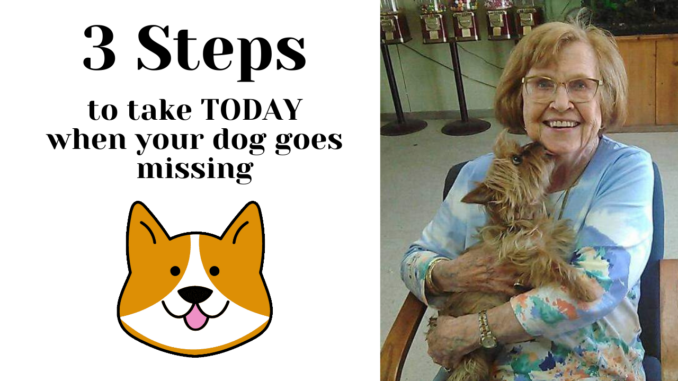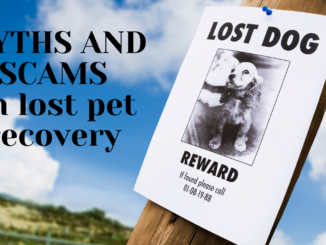
You can greatly increase your chances of finding your lost dog quickly by utilizing these effective search techniques.
You arrive home from work to find the gate open and your dog nowhere to be seen. Your dog jumps out of the car while you’re at the grocery store and vanishes. You’re out on a walk when your dog slips out of his collar and takes off. There are many ways that dogs go missing, and the quicker you take effective action, the more likely you are to recover him. Read on for the top three steps to take TODAY to find your lost dog.
1) Take action immediately

The first step to take is to conduct a physical search. Don’t just walk around the neighborhood calling his name — stop and think for a minute before commencing your search, and create a strategy. The first consideration is how did he go missing, and from where? Each scenario will require a different search.
Missing from home
If your dog was inside, look all over the house to determine how he got out. Is a door or window open? Talk with your housemates. Did someone let him out or take him for a walk? Maybe they still have him. If not, you can determine the time he might have gone missing. If you don’t see an obvious sign of escape, he may still be in the house. This is more common for cats, but can also happen to dogs. He may be stuck in a spare room, closet, or garage if an open door shut behind him.
If your dog was outside, check the perimeter. Does your fence have weak spots? Is the gate open? Does it appear that a package delivery driver or other person came on your property that day? Is your dog a jumper? Has he gotten out of the yard before? If so, how, and where was he found? Make sure he is not still on the property before searching elsewhere. Once you are sure, start walking up and down the streets immediately around your home. If you don’t see any sign of him, you can drive around to cover a larger area, but be aware that it is easier to miss things while concentrating on driving. For this reason, it may be a good idea to have a friend or family member drive while you look.
Missing from a walk
If your dog went missing while on a walk, you will want to start your search at the point where he went missing. If you were walking him, you will know where this is. If he was lost by a dog walker or friend, ask them exactly where they were and where they were going.
What was the reason he ran away? Did he want to chase a squirrel or other animal? Was he frightened by something in the environment? Did he just have a desire to run? These will give you clues as to which way he ran and how far he went.
If you take the same walk every day, he will likely follow the pattern of the walk, stopping at favorite places like a park, grassy area, or bushes where he likes to sniff, pee, or explore. If you take different walks, start searching in all of your usual areas. You are likely to spot him if he went missing just recently, but if it has been more than an hour you may want to search by car to cover a larger area.
Missing from an unfamiliar area
If your dog goes missing from the parking lot of the vet hospital, boarding facility, friend’s house, or other unfamiliar location, your search can be a little more tricky. Your dog may run towards other people, explore, or hide. It’s hard to know which way he will go if he can’t orient towards home or a favorite place like a park.
Personality considerations
Your dog’s personality will determine the best way to search. If he is playful and outgoing, he will likely run up to you when he sees you, or up to another person. If he is shy or fearful, he will more likely run away from people, even you, and hide. Newly adopted dogs often go missing, and this can be especially challenging as the dog doesn’t know where he is and isn’t bonded with the family. Stay tuned for future articles on preventing a newly adopted dog from going missing.
If he is old or ill, he likely won’t go far. Old dogs sometimes become confused, even on their own property or a short distance from it, so be very thorough in your search. I have been personally involved in elderly lost dog cases where the dog was found in a ditch, in the bushes, in the nearby woods, or across the street, either too confused or weak to return home.
If you have other dogs in the home and they get along, take the other walking with you while you search. Dogs are often attracted to other dogs and may come out of hiding and follow along. When I was pet sitting full time, I often brought one of my dogs with me for the day. I helped recover a number of wandering lost dogs because they were curious about mine and approached, allowing me to slip a lead over their head and check their ID tags, or to call animal control if there was no ID.
Do not chase!
If you see your dog while searching, resist the urge to run after him! This is a common response that never ends well. Many dogs, even friendly ones, will run away when chased. In fact, as they are chased more and more by folks trying to catch them, they will become skittish and avoid people altogether, making them more difficult to catch. Instead, encourage your dog to come to you by using food lures and calming signals.
2) Check the shelter

If your physical search does not locate your dog, you will need to check any local shelters that provide animal control for your area. If you don’t know where to go, start by calling the non-emergency line for your local law enforcement. Police work in cooperation with animal control, so they will know how to advise you. You can also do a Google search for “animal shelter near me.” Today shelters have many new restrictions due to covid, so be sure to call first and be advised of business hours and procedures before driving down there.
Dogs are more likely than cats to end up in a shelter for several reasons. One, people are more likely to notice a wandering dog and call animal control or try to catch it than a cat. Many cats live outside and are not even noticed. Two, most places have laws against dogs at large. These laws stem from rabies control and from the possibility of roaming dogs biting people or causing a traffic accident.
Microchip and other ID
If your dog is wearing a collar with ID tags, great! This is the easiest way for a finder to get in touch with you. Keep in mind that collars or tags can come off when a dog is at large, so don’t rely on this and wait for a call. If your dog is microchipped, make sure that the chip number is correctly and currently registered. Detailed info on how to do that in this article and video.
Don’t delay
Hold periods are very short in animal shelters, In California, the minimum legal hold period is just 72 hours! If you don’t find and reclaim your dog at the shelter within that time frame, he could be adopted, transferred to another shelter or rescue group, or even euthanized.
When you go to the shelter, check in with the customer service staff. They will walk you through the lost pet procedure and show you all the dogs in care. Do not just walk around by yourself. Many people make this mistake because they don’t want to stand in line or wait for someone to help them. The animals in public view are usually only those up for adoption, not recently picked up strays. There may also be other dogs at the vet hospital or another location that you should be made aware of.
Cover all bases
There are a number of different places that act as repositories for stray animals: government shelters, humane societies, pet hospitals, and foster homes. You will want to check with all of these possibilities. When you talk with your local law enforcement or the shelter you visit, ask them where else you might look for a lost dog. Check any pet hospitals in your area. While not all will take in or hold stray pets, many will hear from finders wanting to know what to do, and they may take in found animals for emergency medical treatment until the owner can be located. While adoption-only shelters, often called humane societies or the SPCA, don’t officially do animal control, many will accept drop offs of found pets, so be sure the check every possibility. Also check shelters for neighboring cities, as the finder of your dog may not be familiar with the area and may take him to an alternate location.
Follow up
Don’t assume because you visited the shelter one time you’re all set. Shelter workers are very busy and receive many lost dog reports every day. The likelihood of the shelter matching your lost report with a found dogs days or weeks later is very slim. Most shelters post pictures of the pets in care online so you can check that at any time. Call and visit in person as often as you can, keeping in mind that short holding period. Even if your dog is microchipped, you still need to check. While I recommend that all dogs be chipped, it’s not a perfect system. The shelter worker could scan improperly or the scanner could be malfunctioning or have a low battery. Don’t wait for a call because your dog is microchipped.
3) Notify neighbors

Many dogs are recovered with the help of neighbors. Someone has seen something, but they may not know you and don’t know how to help. Getting the word out will put many eyes on your search and greatly increase your chances of success.
Door knocking
In the covid age, folks may not take kindly to door knocking. However, I would still recommend it in many cases. Wear your face covering and announce the reason for your visit while knocking. If no one comes to the door, leave your flyer under the mat or someplace else where the resident can see it. If they open the door or speak from within, ask if they have seen your dog and if they could please keep an eye out, then leave your flyer. If they have any information, write it down and follow up.
Posters, flyers, and mailers
For detailed info on posters, flyers, and mailers, check out this article and video. Flyers can be quickly printed from your home computer with some basic information and a good picture of your dog. Carry these with you as you search the neighborhood and give them to anyone you speak with. Encourage them to contact you right away if they think they see your dog. Flyers can be placed under door mats or on cork boards. Don’t put them in mailboxes as you could get into hot water with the postal service.
Posters can be made if you don’t find your dog right away. Proper construction and placement (see referenced link above) will go a long way in generating helpful leads.
Mailers are a good tool to use when some time has passed, a week or more, and you aren’t getting good leads. Mailers go to every home in any given area, ensuring that everyone is aware of your search.
Follow up on leads
Your outreach should generate leads from helpful folks. You will want to follow up on these leads as best you can. Use logic to decide which ones are more likely to be your dog. Sightings reasonably near where your dog went missing are highly probable, while sightings 10 miles away are less so. That said, dogs can travel far on foot, especially if some time has passed, and they can also be transported in a vehicle by a finder. Multiple sightings from different people in the same area are a really good sign. You will have to decide which leads to pursue. Ask finders to text you a photo if at all possible. Today, everyone has a cell phone with a camera, so this should not be difficult.
When following leads, be aware and remember safety first! Do not go on private property unless you have permission. Search during the day and bring someone with you if possible. You know your area best, so use common sense and don’t wander into places that might get you into trouble. Carry flyers so if someone asks what you are doing you can engage them to help you.
Many dogs are found weeks or even months after going missing, so don’t get discouraged if you aren’t successful right away. Owners who actively search with effective methods will find their dog.





Be the first to comment